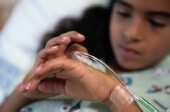- Skip Storing This Everyday Product in the Fridge Door
- Green Tea + B3 Pairing May Boost Brain Health
- Navigating Your Midlife Crisis: Embracing New Possibilities
- City Raccoons Showing Signs of Domestication
- Mapping the Exposome: Science Broadens Focus to Environmental Disease Triggers
- One Week Less on Social Media Linked to Better Mental Health
- Your Brain Changes in Stages as You Age, Study Finds
- Some Suicide Victims Show No Typical Warning Signs, Study Finds
- ByHeart Formula Faces Lawsuits After Babies Sickened With Botulism
- Switch to Vegan Diet Could Cut Your Greenhouse Gas Emissions in Half
Drug Interactions Common Among Hospitalized Kids, Study Says


When children land in the hospital, they are often given multiple drugs that could interact with each other in potentially harmful ways, a study of U.S. hospitals finds.
Researchers found that among nearly 500,000 children and teenagers who were hospitalized in 2011, nearly half were given combinations of drugs that could have potential interactions.
Those interactions could potentially boost the risk of side effects, like sedation or breathing suppression. But the bigger concern may be that one drug could reduce the effectiveness of another, said senior researcher Dr. Chris Feudtner, of Children’s Hospital of Philadelphia.
However, Feudtner stressed that while the study found many cases of potential drug interactions, it’s not clear how often children were actually harmed.
“I don’t want parents of hospitalized children to think they shouldn’t get any medications,” Feudtner said. “That is emphatically not the take-away.”
One reason is that hospitalized children are typically seriously ill and need multiple drugs. Another, Feudtner said, is that they’re being monitored around-the-clock, so drug side effects can be caught and managed.
Instead, Feudtner said the findings highlight a need for “more rational” systems of alerting doctors to potentially serious drug interactions.
Right now, hospitals have electronic systems that sound alerts when a patient is being given drugs that can interact with each other. But since so many medications have that potential, doctors are often bombarded with alerts. Doctors may end up ignoring such alarms due to “alert fatigue,” background information in the study suggests.
Feudtner called it the “boy who cried wolf” problem.
The study, reported online on Dec. 15 in Pediatrics, is based on a year’s worth of administrative records from 43 U.S. children’s hospitals. Feudtner’s team looked for potential drug interactions in each patient’s case by checking a standard alert system used by hospitals.
Overall, 49 percent of children were given at least one drug combination with potential interactions. Opioid painkillers, such as morphine and oxycodone, were the drugs most often involved, followed by antibiotics and other infection fighters, according to the study.
The potential side effects, according to Feudtner’s team, included breathing problems, bleeding, reduced iron absorption and sedation. But the researchers had no information on how often any side effects actually arose.
Still, other studies have suggested that actual adverse drug reactions are much less common than the rate of potential interactions in this study, Feudtner said.
A pharmacy specialist who reviewed the study said that for hospital staff, the findings highlight the importance of being aware of potential drug interactions. But decisions on treatment ultimately come down to an individual child’s circumstances, said Enrico Ligniti, director of pediatric pharmacy services at Cohen Children’s Medical Center in New Hyde Park, N.Y.
“It’s always going to be a balance, because each individual is unique,” Ligniti said.
But parents do not have to feel powerless, according to Ligniti. “You can always feel empowered to ask questions about medications and medication side effects,” he said. “And feel free to talk to the hospital pharmacist.”
“You’re your child’s greatest advocate,” Ligniti said.
More information
The U.S. Food and Drug Administration has more on prescription drug safety.
Source: HealthDay
Copyright © 2025 HealthDay. All rights reserved.










